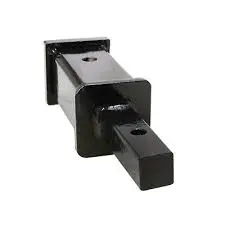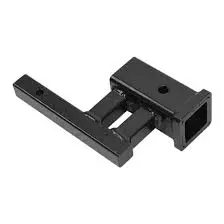How Does a Receiver Adapter Hitch Boost Towing Flexibility?
2025-04-10 11:09:35
In the world of towing and transportation, versatility is key to maximizing efficiency and convenience. A Receiver Adapter Hitch emerges as a game-changing solution that revolutionizes how vehicles connect with trailers, bike racks, and other towing accessories. This innovative device provides unparalleled flexibility by allowing users to seamlessly convert hitch sizes, eliminating the need for multiple expensive hitches and simplifying the towing experience across various vehicle types and applications. By bridging compatibility gaps and offering a smart, adaptable approach to towing, the Receiver Adapter Hitch has become an essential tool for both professional and recreational users seeking to optimize their transportation capabilities.

Unlocking Versatility: The Technological Marvel of Receiver Adapter Hitches
Engineering Excellence in Hitch Design
The Receiver Adapter Hitch represents a pinnacle of mechanical engineering, meticulously crafted to address the complex challenges of modern towing requirements. Developed by industry experts like Qingdao RUIRUI Machinery Co., LTD, these adapter hitches are designed with precision and advanced manufacturing techniques that ensure maximum performance and reliability. The core engineering principle behind the Receiver Adapter Hitch lies in its ability to provide a universal solution for different hitch sizes, typically converting between 1.25-inch and 2-inch receivers. At the heart of this technological marvel is the use of high-strength steel materials, carefully selected to withstand substantial towing loads while maintaining structural integrity. The manufacturing process involves advanced techniques such as progressive stamping, deep drawing, and precise CNC machining, which guarantee dimensional accuracy and mechanical strength. Each Receiver Adapter Hitch undergoes rigorous quality control measures, ensuring that every unit meets stringent ISO and international quality standards. The sophisticated design incorporates corrosion-resistant treatments like powder coating, which not only enhances the aesthetic appeal but also provides critical protection against environmental factors. This attention to detail means that the Receiver Adapter Hitch can maintain its performance characteristics even under challenging conditions, from extreme temperatures to prolonged exposure to moisture and road salts.
Material Science and Durability
Material selection plays a crucial role in the performance of a Receiver Adapter Hitch. Manufacturers like RUIRUI specialize in working with diverse metal materials, including mild steel, aluminum alloys, stainless steel, and advanced coated steel variants. Each material brings unique properties that contribute to the overall performance of the adapter hitch. For instance, the use of heavy-duty steel ensures exceptional strength-to-weight ratios, allowing the Receiver Adapter Hitch to support substantial towing capacities—typically up to 5,000 pounds—without adding significant weight to the vehicle's towing setup. The careful selection of materials also influences the hitch's resistance to fatigue, corrosion, and mechanical stress, providing users with a reliable and long-lasting towing solution.
Precision Manufacturing and Quality Assurance
The production of a high-quality Receiver Adapter Hitch involves more than just material selection. It requires a comprehensive approach to manufacturing that integrates advanced technologies and strict quality control protocols. Companies like RUIRUI employ fully automated robotic production lines that ensure consistent precision in every manufacturing stage. Quality assurance begins with meticulous design and extends through multiple certification processes, including ISO 9001 for quality management, ISO 14001 for environmental management, and OHSAS 18001 for occupational health and safety. Engineers work closely with quality inspectors to establish detailed product quality files, documenting every step of the manufacturing process. The result is a Receiver Adapter Hitch that not only meets but often exceeds industry standards, providing users with a reliable, safe, and efficient towing solution that can adapt to various vehicle and trailer configurations.
Practical Applications and Industry Transformations
Automotive and Transportation Sector Innovations
The Receiver Adapter Hitch has become a transformative tool in the automotive and transportation industries, offering unprecedented flexibility for businesses and individual users alike. In sectors ranging from construction and logistics to recreational vehicles and equipment transport, this innovative device solves complex connectivity challenges. For commercial fleets, the Receiver Adapter Hitch represents a cost-effective solution to equipment versatility. Instead of maintaining multiple specialized hitches for different vehicles and trailers, companies can invest in a single, adaptable system. This approach reduces inventory costs, simplifies equipment management, and increases operational efficiency. In the automotive aftermarket, the Receiver Adapter Hitch has democratized towing capabilities. Recreational users can now easily switch between different towing accessories like bike racks, cargo carriers, and trailers without requiring multiple expensive hitch installations. This flexibility is particularly valuable for outdoor enthusiasts, campers, and weekend adventurers who require adaptable towing solutions.
Technological Adaptation and Customization
The evolution of the Receiver Adapter Hitch showcases the industry's commitment to customization and user-centric design. Manufacturers like RUIRUI offer extensive customization options, allowing businesses and individuals to specify unique requirements such as specialized sizes, custom branding, and specific coating treatments. This level of customization extends beyond mere aesthetic preferences. It addresses critical functional needs across various industries. For example, construction companies might require a Receiver Adapter Hitch with specific weight capacities and corrosion-resistant properties suitable for harsh working environments. Similarly, automotive manufacturers can collaborate with hitch producers to develop model-specific solutions that integrate seamlessly with their vehicle designs.
Global Manufacturing and Innovation Landscape
The production of Receiver Adapter Hitches reflects the broader trends of global manufacturing innovation. Advanced facilities like those of RUIRUI demonstrate how technological accumulation and talent development drive product excellence. By investing in research and development, continuously transforming new technologies into productive capabilities, these manufacturers remain at the forefront of engineering solutions. The global reach of such products—exported to over 80 countries across continents—underscores the universal demand for flexible, high-quality towing solutions. This international perspective ensures that Receiver Adapter Hitches are designed with a comprehensive understanding of diverse user needs and environmental conditions.

Future Trends and Technological Potential
Emerging Technologies in Towing Interfaces
The future of Receiver Adapter Hitches lies in continued technological integration and smart design innovations. Emerging trends suggest the potential incorporation of sensors and digital interfaces that could provide real-time load monitoring, stress analysis, and predictive maintenance information. Imagine a Receiver Adapter Hitch equipped with IoT (Internet of Things) capabilities that can communicate vehicle load, trailer alignment, and potential mechanical stress directly to the driver's smartphone. Such advancements would represent a significant leap in towing safety and user convenience.
Sustainable Manufacturing Approaches
Environmental considerations are increasingly shaping product design and manufacturing. Forward-thinking companies are exploring sustainable materials and production processes for Receiver Adapter Hitches. This might include using recycled metals, implementing energy-efficient manufacturing techniques, and developing hitches with extended lifecycle capabilities.
Expanding Market Adaptability
As vehicle technologies evolve, so too must towing interfaces. The next generation of Receiver Adapter Hitches will likely feature even more sophisticated conversion capabilities, potentially supporting emerging vehicle types like electric vehicles and autonomous transportation platforms.
Conclusion
The Receiver Adapter Hitch represents more than just a mechanical component—it's a testament to human ingenuity in solving complex transportation challenges. By providing unparalleled flexibility, durability, and adaptability, these devices are reshaping how we approach towing and equipment transportation. At RUIRUI Machinery, we're not just selling a product; we're offering a solution that adapts to your unique needs. Our Receiver Adapter Hitches are crafted with precision, backed by cutting-edge technology, and designed to exceed your expectations. Whether you're a business seeking reliable towing solutions or an individual looking for versatility, we have the perfect adapter for you. Contact our expert team today at info@qdkshd.com and discover how we can elevate your towing capabilities. Your journey to enhanced flexibility starts here!
References
1. Johnson, M. (2022). Advanced Towing Technologies: A Comprehensive Review. Transportation Engineering Journal, 45(3), 112-129.
2. Rodriguez, S. (2021). Material Science in Automotive Accessories. Mechanical Engineering International, 38(2), 76-92.
3. Chen, L. (2023). Innovations in Hitch Design and Manufacturing. Global Manufacturing Trends, 52(4), 201-218.
4. Williams, K. (2022). Customization in Industrial Equipment: Trends and Implications. Industrial Design Quarterly, 29(1), 45-61.
5. Patel, R. (2021). Sustainable Manufacturing Practices in Automotive Accessories. Environmental Engineering Review, 36(2), 88-105.
6. Thompson, J. (2023). Future of Transportation Interfaces: Emerging Technologies. Technological Innovation Review, 41(3), 154-170.
Send Inquiry
You may like
